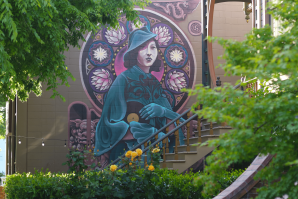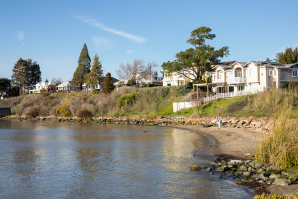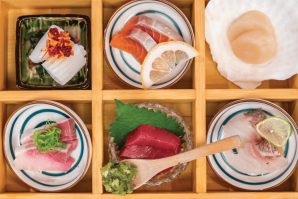Cherry blossoms, or sakura, are iconic flowers heralding the arrival of spring in Japan. During this season, many take part in hanami, meaning flower viewing, where people gather beneath canopies of blossoms to enjoy the ephemeral beauty of the season. Soon, Sacramentans will be able to take part in this tradition. After more than 10 years of planning, Sacramento’s cherry blossom park, Hanami Line, officially opened June 20 of last year — making this spring the park’s first bloom.
Nestled inside Robert T. Matsui Park and stretching alongside the Sacramento River, Hanami Line is a tranquil space visible to commuters from Interstate 5. Directly adjacent to the Museum of Science and Curiosity, it’s within walking distance to The Railyards and about a mile and a half from Old Sacramento. “Parks serve as a critical third space for our community,” says Jessica Sanders, executive director of the Sacramento Tree Foundation. “Third spaces have been shown to be pivotal to human wellbeing, happiness, and sense of community. With more people working remotely, Hanami Line at Robert T. Matsui Park serves as a place to connect, recharge, relax and celebrate our city.”
While spring has officially begun in Sacramento, just a couple of
the park’s 100 “Pink Flair” cherry trees have sprouted tiny,
vibrant pink blossoms.

But the park is designed to hold meaning even when the flowers are not in bloom. One of the attendees at the grand opening in June was Jim Tabuchi, the program facilitator for Sacramento’s Reclaim Japantown, an organization created to help raise awareness about the history of Japanese Americans in Sacramento. He sees Hamani Line as a powerful gesture of remembrance. “Most of the Japanese Americans came to Sacramento by boat,” says Tabuchi. “And this river was the means for them to get here. So for this park to be here really signifies the beginning of that.”
Trees are planted on two levels, with twig-shaped concrete benches scattered throughout the space and wooden benches made from the Foundation’s Urban Wood Rescue program. At the end of the wave-patterned, blue-tiled Matsuyama Dori (walkway), a 20-foot-tall cherry blossom sculpture points in the direction of Matsuyama, Sacramento’s sister city in Japan.
“The linkage between Sacramento and Matsuyama is key,” says Tabuchi. “If you were to draw a straight line 5,000 miles from here to Japan, you would hit Matsuyama through this path. So, every end of March and early April, this will be an opportunity for us to celebrate Japanese American heritage back here at the park.”
This tile on Hanami Line’s Matsuyama Dori (walkway) was a gift
from Sacramento’s sister city.

The idea originally took root over 10 years ago when author and political consultant Joe Rodota visited Japan and experienced hanami firsthand. He and colleague Lon Hatamiya created the community organization Sakuramento in order to focus on support for the idea and create a social connection within the community. “It was all done in a collaborative fashion to ensure we could get the Hanami Line built,” says Hatamiya. The two co-chairs then brought the idea to the Sacramento Tree Foundation, and they began taking proposals the following year. “The Tree Foundation took it on as their Capital Project,” he explains. “I give them all the credit for the raising of the funds to get to where we are today.”
“This project went through a lot of hard work by many dedicated people,” says Sanders. A collective effort included everyone from the Capital Campaign committee made up of board members, staff members and donors of the Sacramento Tree Foundation that handled fundraising, to the Foundation’s board, community members, city staff and volunteers. “It took many people hours to build the park,” says Sanders. “I know that everyone who worked on this project feels a deep and lasting impact for our community.”
In addition to creating a new multi-use public space, Hanami Line provides an opportunity to reflect on Sacramento’s history and the Japanese immigrants who came to the region in the late 19th century in search of work opportunities. By the 1920s, Sacramento had the fourth-largest Japanese population of any city in the United States. Sacramento’s Japantown, which flourished between 3rd and 5th streets and L and O streets, was bustling.
However, after World War II and the bombing of Pearl Harbor, Executive Order 9066 was signed by President Roosevelt, and more than 100,000 Japanese American citizens were sent to internment camps along the West Coast. “Everyone was given a very short time to shutter their business, close up their houses or apartments, and try to sell off or store their goods,” explains Tabuchi of Reclaim Japantown. Although many returned after the war’s end and began to successfully rebuild, the Capitol Mall Redevelopment Plan and construction of the Interstate 5 freeway saw Japantown and the diverse West End neighborhood destroyed and remaining families and businesses pushed out.
“So this park is one of the only places in Sacramento that really reclaims that history,” he says. “When there’s been so much erasure, we have this to be able to celebrate. I applaud the Sacramento Tree Foundation and Lon Hatamiya with his foresight for the city of Sacramento and the Parks Department to locate it here by the river because that really holds a lot of significance.”
The Sacramento Tree Foundation has a calendar of upcoming activities planned for Hanami Line. On April 26 the River District is holding an event called Trails in Bloom that starts with a park cleanup at Township Nine followed by a bike ride to Hanami Line for a special event. Visit www.sactree.org/events for more information.
–
Stay up to date on business in the Capital Region: Subscribe to the Comstock’s newsletter today.
Recommended For You

A Japantown Jazz Star Comes Home
1936 film starring Sacramento-born singer Betty Inada is screened in Sacramento
Betty Inada, a Japanese American jazz singer born in Sacramento in 1913, sought fame in Japan in a time when American screens and stages had little space for Asian women.

This Small Town by the Sea Brings ‘Authentic Energy’
Benicia’s First Street offers an eclectic array of historic sites, shops and restaurants
The Solano County city of fewer than 30,000 residents is also an easy day trip for visitors from Sacramento and the Bay Area, with a 10-block stroll along Benicia’s First Street providing a unique opportunity to visit 300 eclectic businesses amidst 19th-century Victorian buildings — all while basking in bay views a couple of blocks away.

History in Our Backyard
Past meets present in these quaint old towns that tourists are eager to explore
Auburn, Benicia, Folsom, Lodi and Truckee: five Northern California gems you’ll want to visit this summer.

Omakase Reimagined
The Japanese tasting menu concept is branching out to other cuisines
Omakase has evolved from a Japanese culinary tradition mostly associated with high-end sushi restaurants to a dining concept that accommodates a wide range of palates.



